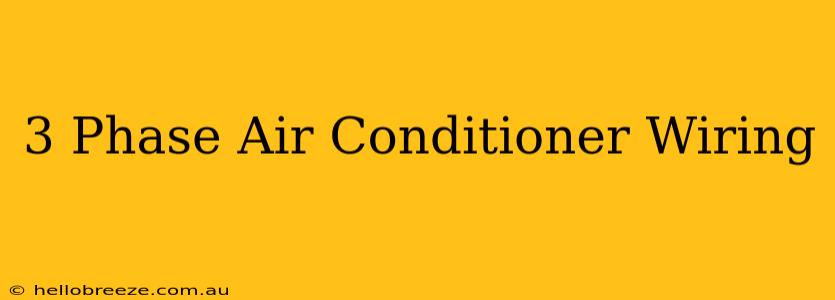Wiring a 3-phase air conditioner correctly is crucial for its efficient and safe operation. This guide provides a detailed walkthrough, covering safety precautions, necessary components, and step-by-step instructions. Improper wiring can lead to malfunctions, damage to the unit, and even fire hazards, so careful attention to detail is paramount.
Understanding 3-Phase Power
Before diving into the wiring process, it's essential to understand the basics of 3-phase power. Unlike single-phase power, which uses two wires (hot and neutral), 3-phase power uses three hot wires and a neutral wire (in some configurations). These three hot wires are 120 degrees out of phase with each other, providing a more stable and efficient power supply, ideal for larger appliances like 3-phase air conditioners.
Key Components for 3-Phase AC Wiring
- Disconnecting Means: A properly sized and rated disconnect switch is mandatory for safety and maintenance. This allows you to completely isolate the power supply to the air conditioner.
- Circuit Breaker: A correctly sized circuit breaker protects the wiring and the air conditioner from overcurrent conditions. The size depends on the air conditioner's amperage rating.
- Wiring: Use appropriately sized and insulated copper wiring capable of handling the air conditioner's amperage and voltage. Consult the air conditioner's specifications for the correct wire gauge.
- Conduit: Protect the wiring with a metal conduit to prevent damage and ensure safety.
- Voltage Tester: This is an essential safety tool to verify the absence of power before working on the wiring.
- Air Conditioner Specifications: Always refer to the manufacturer's specifications and wiring diagram for your specific air conditioner model. These diagrams are crucial for correct wiring.
Step-by-Step Wiring Instructions: A General Guide
Disclaimer: This is a general guide. Always consult your air conditioner's specific wiring diagram and local electrical codes. Incorrect wiring can be dangerous. If you are not comfortable working with electricity, hire a qualified electrician.
-
Safety First: Turn off the power at the main breaker panel before starting any wiring work. Use a voltage tester to verify that the power is off at the air conditioner's connection point.
-
Prepare the Wiring: Cut the wires to the appropriate lengths, ensuring sufficient slack for easy connection. Strip the insulation from the ends of the wires, exposing the copper conductors. Carefully follow the wire gauge specifications from your air conditioner’s manual.
-
Connect the Wires: Connect the wires to the air conditioner's terminal block according to the wiring diagram. Usually, the wiring diagram on the unit will identify the terminals clearly. Ensure a secure and tight connection, avoiding loose wires. The most common configurations are Delta and Wye. This is where the specific unit's wiring diagram becomes essential.
-
Grounding: Connect the grounding wire to the appropriate grounding terminal on the air conditioner and the electrical panel. Grounding is critical for safety and prevents electrical shocks.
-
Secure the Connections: Carefully tuck the wires into the junction box or conduit system. Use wire nuts or other appropriate connectors to ensure a secure connection.
-
Reconnect the Power: After all connections are securely made and verified, turn the power back on at the main breaker panel.
-
Testing and Verification: Turn on the air conditioner and check for proper operation. If you notice any problems such as unusual noises, overheating, or a tripped breaker, immediately turn off the power and consult a qualified electrician.
Troubleshooting Common Problems
- Air Conditioner Not Working: This could be due to incorrect wiring, a tripped breaker, a faulty compressor, or other issues. Check the wiring, the circuit breaker, and consult the troubleshooting section in your air conditioner's manual.
- Overheating: This might indicate a problem with the compressor, refrigerant, or other internal components. Call a qualified HVAC technician for diagnosis and repair.
- Tripped Breaker: This suggests an overcurrent situation, possibly due to a short circuit, faulty wiring, or an overload. Check the wiring for any damage or loose connections.
Maintaining Your 3-Phase Air Conditioner
Regular maintenance, including checking wiring connections and cleaning the condenser coils, will prolong the life of your air conditioning unit. Consult your owner's manual for recommended maintenance schedules.
Remember: This information is for guidance only. Always consult a qualified electrician for installation and any electrical work. Improper wiring is extremely dangerous. Always prioritize safety.

